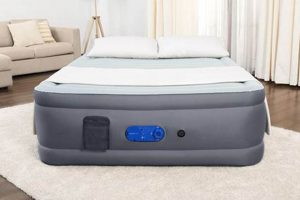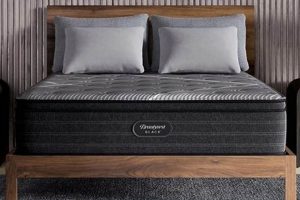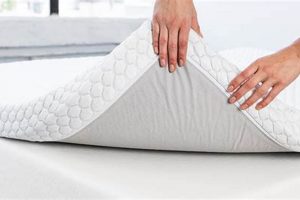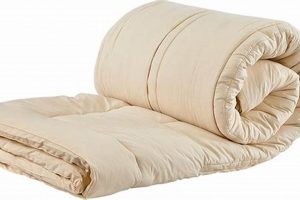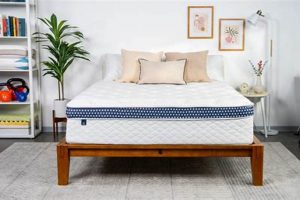A sleeping surface specifically designed for the dimensions and constraints of a bunk bed frame, optimized for comfort and safety within that elevated structure, is a crucial component of any bunk bed setup. These mattresses typically prioritize a thinner profile to adhere to safety guidelines, preventing excessive height that could compromise the safety rail’s effectiveness. For example, a six-inch memory foam model often serves as a suitable option.
Selecting a suitable sleeping surface for a bunk bed offers multiple advantages. It ensures a safe sleeping environment by preventing occupants from exceeding the safety rail height. Furthermore, it contributes to the overall comfort and sleep quality of the user. Historically, in shared living spaces, bunk beds addressed spatial limitations, and the development of appropriate mattresses became increasingly important to enhance the sleeping experience in these configurations.
Therefore, considerations for thickness, material composition, support, and safety certifications are paramount when choosing a sleeping surface tailored to a bunk bed. The following discussion will delve into these factors, providing a detailed guide to inform the selection process.
Selection Tips for Bunk Bed Mattresses
The following tips provide guidance for choosing a suitable sleeping surface for a bunk bed, focusing on factors that ensure both comfort and safety.
Tip 1: Prioritize Thickness. Select a mattress with a thickness that adheres to the bunk bed frame’s safety recommendations. Exceeding the maximum recommended thickness reduces the effectiveness of the safety rails, posing a potential hazard.
Tip 2: Consider Material Composition. Explore various mattress materials such as memory foam, innerspring, or latex. Memory foam provides contouring and pressure relief, while innerspring offers firmer support. Latex is a durable and hypoallergenic option.
Tip 3: Evaluate Support and Firmness. Determine the appropriate level of firmness based on the sleeper’s preferences and sleeping position. Side sleepers often benefit from a softer surface, while back and stomach sleepers typically require firmer support.
Tip 4: Verify Safety Certifications. Ensure that the mattress is certified by reputable organizations such as CertiPUR-US or GREENGUARD Gold. These certifications indicate that the product has been tested for harmful chemicals and emissions.
Tip 5: Assess Weight Capacity. Verify that the mattress’s weight capacity aligns with the intended user. Exceeding the weight limit can compromise the mattress’s structure and lifespan.
Tip 6: Measure Accurately. Precisely measure the bunk bed frame’s dimensions to ensure a proper fit. An ill-fitting mattress can create gaps that pose safety risks.
Tip 7: Consider the User’s Age. For children, a firmer, more supportive mattress is often recommended to promote proper spinal development. Teens and adults may have varying comfort preferences.
By considering these factors, one can select a bunk bed mattress that optimizes safety, comfort, and durability, providing a restful and secure sleeping experience.
The next section will cover specific mattress types and their suitability for bunk bed use.
1. Thickness
Thickness constitutes a critical factor in the selection of a bunk bed mattress. Its influence extends beyond mere comfort, directly impacting the safety and functionality of the bunk bed system. Choosing a mattress with appropriate thickness mitigates potential hazards and optimizes the sleeping environment.
- Safety Rail Clearance
Excessive mattress thickness reduces the effective height of the safety rails, increasing the risk of falls, particularly for upper bunk occupants. Bunk bed manufacturers specify maximum mattress thickness limits to ensure adequate rail protection. Exceeding these limits compromises safety and violates intended usage guidelines. An example is the recommended thickness is no more than six inches in many cases, as a mattress thicker than that reduces the safety rail clearance below the accepted standard.
- Ladder Accessibility
An overly thick mattress can obstruct access to the ladder or steps leading to the upper bunk. This obstruction creates an awkward and potentially unsafe climbing experience. Proper mattress thickness ensures clear and unobstructed access, promoting ease of use and preventing accidental slips or falls. For example, an eight-inch mattress on a frame designed for a six-inch maximum height could make the top bunk nearly impossible to access.
- Weight Distribution and Support
While thickness contributes to the overall comfort and support provided by the mattress, it’s not the sole determinant. The internal construction and materials also play significant roles. However, excessive thickness without adequate internal support can lead to uneven weight distribution and potential sagging, reducing the mattress’s lifespan and compromising sleep quality. For instance, a very thick but low-density foam mattress may compress excessively, offering inadequate support.
- Frame Compatibility
Bunk bed frames are designed with specific mattress thickness ranges in mind. Using a mattress outside of this range can result in an improper fit, potentially damaging the frame or the mattress itself. Accurate measurement of the frame’s internal dimensions is crucial to ensure compatibility and prevent issues such as the mattress sliding off or being difficult to maneuver. As a case, some frames may require thinner mattresses to allow the bed to function as intended.
These considerations underscore the importance of selecting a bunk bed mattress with appropriate thickness. Prioritizing adherence to manufacturer guidelines and frame specifications is paramount to ensuring a safe, comfortable, and functional sleeping environment within the constraints of a bunk bed system.
2. Support
The relationship between support and a bunk bed mattress is fundamental to user well-being and structural integrity. Support, in this context, refers to the mattress’s ability to maintain spinal alignment, distribute weight evenly, and resist sagging over time. The selection of a sleeping surface deficient in adequate support can lead to discomfort, musculoskeletal strain, and accelerated mattress degradation. A well-supported bunk bed mattress, conversely, promotes restorative sleep and extends the lifespan of both the mattress and the bunk bed frame itself. For example, a mattress constructed with high-density foam or strategically placed coils provides better support than a low-density foam alternative, particularly for individuals with higher body weights or pre-existing back conditions. The cause-and-effect relationship is direct: insufficient support leads to compromised sleep posture
and potential physical ailments; conversely, proper support fosters healthy spinal alignment and a restful sleep experience.
The importance of support is amplified in the context of bunk beds due to space constraints and the potential for multiple occupants. The smaller dimensions of a bunk bed mattress can make it more susceptible to sagging or uneven weight distribution if adequate support is lacking. Furthermore, bunk beds are often used by children or adolescents, whose developing spines require proper support to prevent postural problems. Real-life examples include individuals experiencing back pain or stiffness after sleeping on a poorly supported bunk bed mattress or premature mattress sagging that leads to replacement costs. Addressing this, the selection of a mattress with targeted lumbar support and reinforced edges is essential to prevent roll-off and ensure consistent support across the entire surface.
In conclusion, the provision of adequate support is a non-negotiable attribute of a bunk bed mattress. The benefits of selecting a mattress with sufficient support extend beyond immediate comfort, encompassing long-term spinal health, improved sleep quality, and the preservation of the mattress’s structural integrity. A lack of focus on support can negate other positive features, such as advanced materials or antimicrobial properties. Therefore, evaluating the support characteristics of a bunk bed mattress should be a primary consideration in the selection process.
3. Safety
The correlation between safety and a bunk bed mattress is paramount. Safety directly dictates the suitability of a mattress for bunk bed use, encompassing the minimization of injury risks and the assurance of a secure sleeping environment. Factors such as mattress thickness, material flammability, and adherence to safety standards contribute to the overall safety profile of the mattress. A mattress exceeding the recommended thickness, for instance, negates the protective function of the bunk bed’s safety rails, increasing the likelihood of falls. Mattresses lacking fire-resistant properties pose heightened risks in the event of a fire. The selection of a bunk bed mattress without prioritizing safety introduces unacceptable hazards, particularly for children.
Practical applications of safety considerations are evident in mattress design and certification processes. Manufacturers adhering to safety standards incorporate fire-retardant materials and design mattresses to appropriate thickness specifications. Organizations such as CertiPUR-US and GREENGUARD provide certifications confirming mattresses have undergone rigorous testing for harmful chemicals and emissions, providing consumers with assurances regarding product safety. Real-world examples include instances where non-compliant mattresses have contributed to injuries from falls or fire-related incidents, highlighting the critical need for strict adherence to safety protocols. For instance, a child rolling off the top bunk and getting injured because the mattress was too thick and the safety rail was ineffective.
In summary, the incorporation of safety as a primary consideration in the selection of a bunk bed mattress is non-negotiable. The challenge lies in balancing comfort and affordability with the imperative of safety. Understanding the specific safety requirements for bunk bed mattresses, coupled with careful evaluation of product certifications and adherence to manufacturer guidelines, is essential to ensure a secure sleeping environment. Failing to prioritize safety in this context presents unacceptable risks and compromises the fundamental purpose of the bunk bed as a functional and safe sleeping solution.
4. Durability
Durability, in the context of a bunk bed mattress, refers to its ability to withstand prolonged use and maintain its structural integrity, comfort, and support over an extended period. It is a critical consideration, directly impacting the long-term value and safety of the sleeping surface.
- Material Quality and Longevity
The materials used in a mattress’s construction significantly influence its durability. High-density foams, robust innerspring systems, and durable fabrics contribute to a longer lifespan. For instance, a mattress utilizing high-density memory foam resists compression and retains its shape better than one made with low-density foam. This translates to consistent support and comfort over time, preventing premature sagging and the need for frequent replacement. Real-world examples include mattresses with reinforced edges to prevent breakdown from repeated use getting in and out of the bed.
- Construction and Assembly
The way a mattress is constructed also contributes to its durability. A well-constructed mattress features reinforced seams, secure stitching, and a robust overall design. These elements prevent the mattress from unraveling, tearing, or otherwise deteriorating under normal use. A cheaply constructed mattress may exhibit premature wear and tear, leading to discomfort and the potential for safety hazards. For example, mattresses designed with internal structures to allow airflow reduce the amount of wear and tear.
- Resistance to Sagging and Compression
A durable bunk bed mattress should resist sagging and compression, particularly in areas where weight is concentrated. Sagging can lead to uneven support, discomfort, and potential back pain. Mattresses with reinforced cores and perimeter support are better equipped to withstand weight and maintain their shape. This resistance is particularly important in bunk beds, where weight distribution may not be uniform. For example, mattresses that are flippable give the advantage of evening out the wear and tear and make the mattress more durable.
- Maintenance and Care
Proper maintenance and care practices can significantly extend the lifespan of a bunk bed mattress. Regular cleaning, proper support from the bunk bed frame, and avoidance of excessive weight or stress can all contribute to its durability. Neglecting these practices can accelerate wear and tear, reducing the mattress’s lifespan. For example, using a mattress protector can prevent stains and moisture damage, preserving the mattress’s integrity.
In conclusion, durability is an indispensable attribute of a superior bunk bed mattress. The combination of high-quality materials, robust construction, resistance to sagging, and proper maintenance ensures that the mattress provides consistent comfort, support, and safety for an extended period. This translates to long-term value and peace of mind for the user, making durability a key factor to consider in the selection process.
5. Material
The selection of materials in a bunk bed mattress profoundly influences its comfort, safety, durability, and overall suitability. Material composition determines factors such as support, temperature regulation, hypoallergenic properties, and resistance to wear. The optimal choice of materials balances these considerations to provide a sleeping surface that meets the specific demands of a bunk bed environment.
- Foam Density and Composition
Foam density directly affects the support and longevity of the mattress.
High-density foams provide greater resistance to compression and sagging, ensuring consistent support over time. Memory foam, known for its contouring properties, can relieve pressure points and enhance comfort. Latex foam offers a durable and hypoallergenic alternative. The selection depends on the desired balance between support, comfort, and durability. For instance, a high-density polyurethane foam core provides a firm base, while a memory foam layer offers conforming comfort. - Innerspring Coil Systems
Innerspring mattresses utilize coil systems to provide support and promote airflow. The gauge and configuration of the coils influence the firmness and responsiveness of the mattress. Individually pocketed coils minimize motion transfer, making them suitable for bunk beds occupied by multiple individuals. The type of steel used in the coils affects their durability and resistance to deformation. For example, a higher coil count generally indicates a firmer and more supportive mattress. Lower coil counts with thicker coils allow for greater airflow.
- Fabric Cover and Fire Resistance
The fabric cover serves as the outermost layer of the mattress, impacting breathability, feel, and fire resistance. Natural fibers like cotton offer good breathability, while synthetic fabrics like polyester provide durability. Fire-resistant materials are crucial for meeting safety standards and minimizing fire hazards. Many mattresses incorporate a fire-retardant barrier made from materials such as silica or modacrylic fibers. The textile of the outer layer and how it is stitched may affect the airflow of the mattress. For instance, a quilted cover can enhance comfort, while a tightly woven cover can improve durability.
- Adhesives and Chemical Emissions
The adhesives used to bond different layers of the mattress can impact indoor air quality. Mattresses certified by organizations such as CertiPUR-US are tested for harmful chemicals and emissions, ensuring they meet stringent safety standards. Low-VOC (volatile organic compound) adhesives are preferred to minimize off-gassing and potential health concerns. For example, mattresses using water-based adhesives are typically considered safer than those using solvent-based adhesives. The source of materials is important as well to be sure that production followed safety and environmental regulations.
The optimal material selection for a bunk bed mattress represents a synthesis of these considerations. A durable, supportive, and safe mattress prioritizes high-quality materials, robust construction, and adherence to safety standards. This combination yields a sleeping surface that enhances comfort, promotes healthy sleep, and ensures long-term value within the constraints of a bunk bed environment. It is recommended to view the reviews about the material before purchasing to determine real life experience.
6. Size
Dimensions constitute a foundational element in the selection of a bunk bed mattress. The correct size ensures both safety and optimal utilization of space within the confined parameters of a bunk bed frame. Inadequate attention to size can lead to instability, compromised comfort, and potential safety hazards.
- Standard Bunk Bed Dimensions
Most bunk beds adhere to standard mattress sizes, typically mirroring those of twin or twin XL mattresses. A standard twin mattress measures approximately 39 inches wide by 75 inches long, while a twin XL extends the length to 80 inches. Compliance with these dimensions is essential to prevent overhang or gaps, ensuring a snug and secure fit within the bunk bed frame. An example is a bed that is built for twin only and twin xl mattresses will be sticking out the sides causing discomfort.
- Custom Bunk Bed Frames
Some bunk bed frames deviate from standard dimensions, necessitating custom-sized mattresses. In these instances, precise measurements of the frame’s interior are crucial to avoid discrepancies. Ordering a custom mattress ensures a tailored fit, maximizing comfort and safety. For example, if you create a bed out of reclaimed materials you will need to create a custom sized mattress for it.
- Thickness Considerations
While length and width are paramount, mattress thickness also warrants careful consideration. Exceeding the bunk bed’s recommended maximum thickness can reduce the effective height of the safety rails, compromising their protective function. Adhering to the specified thickness limits is critical for preventing falls, particularly from the upper bunk. As an example, many beds have a recommended thickness for the best safety and a taller mattress takes away from the safety features.
- Weight Distribution and Support
The size of the mattress must align with the intended occupant’s weight and sleeping preferences. An undersized mattress may lack adequate support for heavier individuals, leading to discomfort and potential structural issues. Conversely, an appropriately sized mattress distributes weight evenly, promoting optimal spinal alignment and sleep quality. For instance, a person who is 300 pounds will need a mattress that can withhold that amount of weight.
Ultimately, meticulous attention to size, encompassing length, width, and thickness, is indispensable in the selection of a bunk bed mattress. Accurate measurements, adherence to manufacturer guidelines, and consideration of occupant-specific needs are paramount to ensuring a safe, comfortable, and functional sleeping environment within the confines of a bunk bed system. This also can depend on the age of the occupant as they may need different support.
Frequently Asked Questions
The following questions and answers address common concerns and provide essential information regarding the selection and maintenance of bunk bed mattresses.
Question 1: What is the standard thickness for a bunk bed mattress?
The generally accepted maximum thickness is six inches. Adherence to this limit ensures adequate safety rail height, mitigating the risk of falls.
Question 2: Are innerspring mattresses suitable for bunk beds?
Innerspring mattresses can be suitable, provided they meet thickness requirements and offer adequate support. Models with individually pocketed coils minimize motion transfer, beneficial in shared bunk bed scenarios.
Question 3: How often should a bunk bed mattress be replaced?
Replacement frequency depends on mattress quality, usage, and visible wear. As a general guideline, consider replacement every 7-10 years, or sooner if signs of sagging or diminished support are evident.
Question 4: What safety certifications should one look for when purchasing a bunk bed mattress?
Certifications from organizations such as CertiPUR-US or GREENGUARD Gold indicate testing for harmful chemicals and emissions. These certifications provide assurance regarding product safety.
Question 5: How does mattress firmness affect sleep quality on a bunk bed?
Firmness is subjective and depends on individual preference and sleeping position. Side sleepers often prefer a softer surface, while back and stomach sleepers typically require firmer support to maintain spinal alignment.
Question 6: What is the best way to clean a bunk bed mattress?
Regular vacuuming helps remove dust and allergens. Spot cleaning with a mild detergent can address stains. Consider using a mattress p
rotector to prevent soiling and prolong the mattress’s lifespan.
In summary, prioritizing safety certifications, adherence to thickness limits, and individual comfort preferences are crucial when selecting a bunk bed mattress. Proper maintenance further ensures its longevity and performance.
The next section will provide a comparison of specific bunk bed mattress types.
Concluding Remarks on the Best Bunk Bed Mattress
The preceding discussion has illuminated critical facets of the “best bunk bed mattress,” emphasizing the interplay between safety, support, durability, materials, and size. Informed selection necessitates a comprehensive understanding of these factors to ensure a sleeping surface that promotes well-being and adheres to established safety standards.
The ultimate decision regarding a bunk bed mattress should reflect a considered evaluation of individual needs, budgetary constraints, and a commitment to prioritizing safety above all else. Continued vigilance in adhering to manufacturer guidelines and established safety protocols remains paramount in maximizing the benefits and minimizing the inherent risks associated with bunk bed usage.


